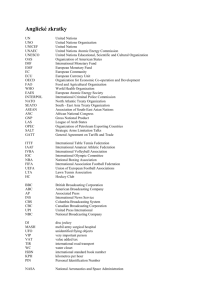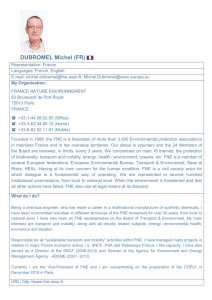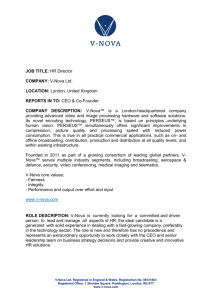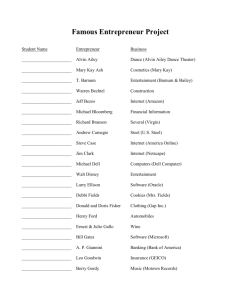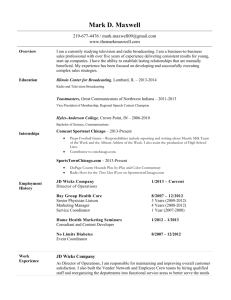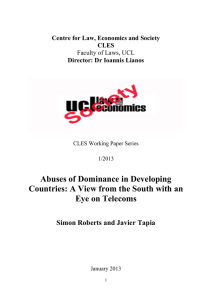Unclassified DAF/COMP/GF/WD(2013)
advertisement
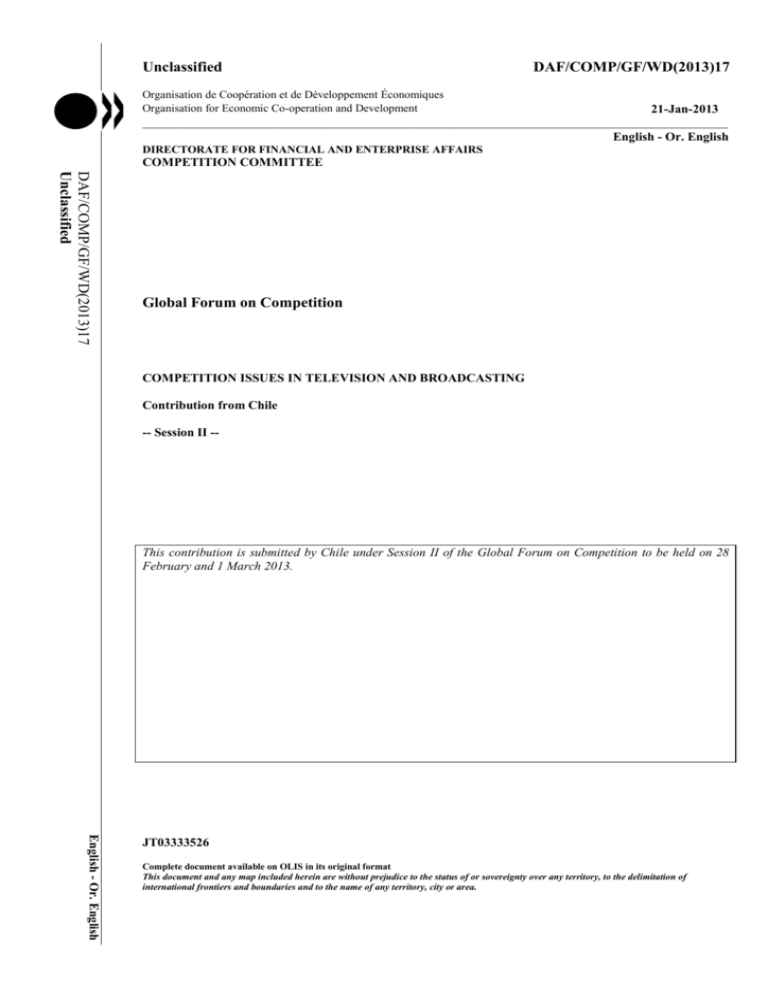
Unclassified DAF/COMP/GF/WD(2013)17 Organisation de Coopération et de Développement Économiques Organisation for Economic Co-operation and Development 21-Jan-2013 ___________________________________________________________________________________________ English - Or. English DIRECTORATE FOR FINANCIAL AND ENTERPRISE AFFAIRS COMPETITION COMMITTEE DAF/COMP/GF/WD(2013)17 Unclassified Global Forum on Competition COMPETITION ISSUES IN TELEVISION AND BROADCASTING Contribution from Chile -- Session II -- This contribution is submitted by Chile under Session II of the Global Forum on Competition to be held on 28 February and 1 March 2013. English - Or. English JT03333526 Complete document available on OLIS in its original format This document and any map included herein are without prejudice to the status of or sovereignty over any territory, to the delimitation of international frontiers and boundaries and to the name of any territory, city or area. DAF/COMP/GF/WD(2013)17 COMPETITION ISSUES IN TELEVISION AND BROADCASTING -- Chile* -- 1. Overview of Television Industry in Chile, Developments in Technology and Regulation 1. The first continuous television (TV) transmissions in Chile date back to the end of the 1950s. During that time, three major TV stations were established and operated by leading universities,1 though TV became a mass media only in 1962 when the soccer World Cup took place in Chile. In 1969, a Stateowned TV station was launched (Televisión Nacional de Chile or TVN). For a long time, it was the only broadcaster with a national scope. 2. The original legal framework2 established a public television system in which the State and universities would be the only broadcasters. However, the system in fact was never solely public, mainly because university operated TV stations rapidly adopted a commercial approach, funding their production and distribution facilities mainly through advertising. Thus, the system in practice was a hybrid that included general interest TV stations operated by universities with commercial funding, and a State-owned TV station with mixed funding between advertisement and public funding. 3 3. Even though major market oriented reforms started relatively soon after the 1973 coup d’état, it was not until 1989, by the end of Pinochet’s regime, that TV broadcasting regulations were amended to allow private ownership and operation of TV broadcasters. Under the new regime, 25-year concessions were granted (in the previous regime, concessions lasted indefinitely) and resulted in the development of new private broadcasters such as Megavisión (1990) and La Red (1991). Rock&Pop station broadcasted TV for about four years between 1995 and 1999, and in 2005, Telecanal entered the market. There has been no other significant entry or exit of players of a national scope in this market, but some developments of regional and local TV stations have taken place. 4. As to technology, over-the-air TV broadcasting initially operated on VHF frequencies. With the introduction of cable TV by the end of the 1980s, some UHF frequencies began to be assigned for local * Contribution submitted by FNE and TDLC. 1 “UCV Televisión” (1957), under Pontificia Universidad Católica de Valparaíso; “Canal 13” (1959), under Pontificia Universidad Católica de Chile; and “Canal 9 or RTU” (1960), under Universidad de Chile. 2 The first broad framework for TV broadcasting was Act No. 17.377 enacted in 1970. It regulated rights, concessions and administration: the State, through TVN, and universities (mostly public bodies at that time) were the only authorized persons allowed to operate TV broadcasting concessions. In the case of universities, the scope of their broadcasting initially was limited to the city where their main studio was located, but further reforms allowed them to broaden the scope. This Act also established the Consejo Nacional de Televisión which is today a constitutionally autonomous public body which duties include to ensure an appropriate performance of the Chilean television from the point of view of the contents disseminated, technological developments and socio-cultural changes in a context of globalization. Details concerning this body are available here: www.cntv.cl 3 TVN received public funds between 1970 and 1990. 2 DAF/COMP/GF/WD(2013)17 transmission. In the 1990s, satellite TV was introduced in Chile, and by 2007, Internet Protocol television (IPTV). Testing of digital TV transmissions began in 2009 and will involve major technological changes. However, until current regulations are amended, full advantages of digital TV are unable to be achieved. This transition is one of the major technological and regulatory challenges the industry faces and will continue to face in the coming years. We will return to this below. 5. A major amendment to the Media Law was introduced in 2001, giving competition authorities the duty of performing ex–ante reviews of media concession transactions, which were mandatory for companies owning concessions subject to the concessions regime (i.e., radio broadcasting and TV broadcasting). With some amendments introduced in 2009, these regulations are still in force and are the main grounds for competition authorities’ involvement in radio & TV broadcasting transactions.4 6. Technological developments in the telecommunications industry have had an impact on TV broadcasting as well. Technological convergence has meant that networks would no longer be associated with a specific kind of service (voice, images or data) as a network originally created for providing a specific service could be used for providing others. Today, telecommunications are broadly associated with transmission of data. And it is no longer possible to associate telecommunication services with a specific device, since today it is possible to talk ‘by phone’ through a computer or to watch a TV signal through a smart phone. 7. Finally, two recent trends in the media industry in Chile are worth mentioning. The first is the development of multi-media conglomerates (parent companies integrating participations in TV broadcasting, radio broadcasting, newspapers and other written periodicals). The second is the entry into media markets of major business groups that are also some of the largest advertisers in TV industry. The following sections will detail the competitive implications of these trends. 2. Competition in the Production of Audiovisual Content and in TV Broadcasting Markets 2.1 Competition in the production of audiovisual content 8. Competition authorities have had very few opportunities to conduct in-depth reviews of the market for the production of audiovisual content. 9. In a few cases, the control (by ownership or otherwise) of a premium content has given rise to competitive issues regarding TV rights associated, for instance, with soccer matches (transmission of 4 Article 38 of the Media Act, according to its original wording, stated that, in the case of media subject to the concessions regime granted by the State, transactions or other relevant contracts must obtain, prior to their closing, a report issued by the corresponding Comisión Preventiva [predecessor of the Competition Tribunal] with respect to their impact on the media market [“mercado informativo”]. Under the 2009 amendments, the report is to be issued by the FNE (and no longer by the TDLC) with respect to the transaction’s effect on competition (and no longer on the ambiguous ‘mercado informativo’). In the case of an unfavorable report by the FNE, the TDLC reviews the report in a non-adversarial proceeding. In a 2012 TDLC’s decision (detailed infra as ‘Radiodifusión SPA/Horizonte’), the FNE claimed that risks associated with the lack of information diversity and pluralism had an impact on another relevant competitive variable: service quality and variety, however the TDLC concluded that the 2009 amendment eliminated from the functions of competition authorities any direct judgment regarding information pluralism and diversity. Nevertheless, the TDLC also noted that these values may be protected or promoted indirectly by means of defending or promoting economic competition in media industries. 3 DAF/COMP/GF/WD(2013)17 soccer goal scorings, national league championship matches, and matches of the Chilean national team).5 In addition, some over-the-air channels have claimed, in proceedings before the Competition Tribunal, that providers of paid TV must pay them for including their open signal in the packages of channels offered to paid TV subscribers.6 10. When the Competition Tribunal approved a merger between the two major cable TV operators, some of the conditions imposed were aimed at mitigating the risks of upstream vertical integration of the merged entity with companies producing audiovisual content.7 11. Finally, the recent trend of entry into media markets by major business groups, which are also important advertisers in the TV industry, may raise questions on how this entry may affect the market for the production of audiovisual content. 2.2 Competition in TV broadcasting 12. Today, the TV broadcasting market in Chile can be divided in two main areas: over-the-air free TV, and paid TV (ADSL cable, coaxial cable, fiber optic cable, satellite). 13. Currently, no TV stations receive governmental subsidies. Even the State-owned station (TVN) must be self-funded, usually via advertising space sales.8 14. Market shares in TV broadcasting market usually are measured using 2 different indicators: audience ratings and advertising space sales. Since this is a two-sided market–advertisers and audience, these indicators reflect participation in each one of these sides. 15. The following table shows average audience ratings for the main over-the-air TV channels in the 5 years between 2007 and 2011: Table 1. Average audience ratings for the main over-the-air TV channels between 2007 and 2011 Year La Red TVN Mega CHV C13 2007 3.4 9.8 9.0 6.9 8.1 2008 2.4 8.4 9.3 7.5 7.9 2009 1.8 9.1 8.6 7.8 8.2 2010 2.0 9.1 8.3 8.3 6.3 2011 2.1 7.8 7.7 8.7 7.7 Source: Time Ibope 5 In the note by Chile to the Roundtable on Competition and Sports, the control of broadcasting rights of soccer matches by “Canal del Fútbol” is identified as an entry barrier to the market of broadcasting soccer matches. OECD, 2010, DAF/COMP/WD(2010)59. 6 Vid. infra ‘Canal 13 et al. vs. VTR et al’, in which the parties reached a settlement. 7 Relevant merger remedies for these purposes included: The merged entity is forbidden to use buying market power unduly against suppliers selling signals or paid TV productions by means of refusing to deal with them or by offering excessively low prices. It is also forbidden for the merged entity to participate as agent or distributor of thematic stations produced domestically or abroad. The merged entity would not be allowed to agree exclusivity terms with respect to broadcasting rights on movies, thematic stations or other domestic or foreign channels, but is allowed to reach such exclusivity agreements for broadcasting specific and isolated events. Vid. infra ‘VTR/Metropolis’. 8 Nevertheless, the State funds specific culturally relevant content productions, via annual public contests. 4 DAF/COMP/GF/WD(2013)17 16. The following table shows participation in years 2007 to 2011, in terms of advertising sales of TV stations: Table 2. Advertising sales of TV stations: Participation from 2007 to 2011 Year CHV TVN C13 Mega La Red Total HHI 2007 16% 32% 31% 16% 5% 100% 2.522 2008 19% 30% 30% 17% 4% 100% 2.457 2009 19% 33% 28% 17% 3% 100% 2.557 2010 25% 33% 21% 18% 3% 100% 2.474 2011 27% 30% 24% 15% 4% 100% 2.446 Source: TDLC on the basis of an economic report submitted by Canal 13 in ‘Radiodifusión SPA/Horizonte’.9 17. Regarding entry in over-the-air TV, the main barrier faced by potential new TV stations is the limited spectrum availability. Even though this might be alleviated once digital TV is fully implemented,10 the need of a policy determination on which category of broadcasting actor should frequency allocations favor will remain. 18. Another characteristic of the Chilean over-the-air TV market is a certain degree of crossownership with other media platforms; specifically, radios and newspapers. Three TV stations are part of multi-media conglomerates, as can be seen in the following table: Table 3. Multi-media conglomerates Conglomerate TV channels Radios Copesa-Dial Station 22 Paula, Duna, Carolina, Disney, Zero, Beethoven Luksic-Canal 13 Bethia El Mercurio Station 9 Play, Sonar, Horizonte, Oasis Candela - Digital, Positiva Station 13 Newspapers La Tercera, Pulso, La Cuarta, La Hora El Mercurio, La Segunda, Las Últimas Noticias, several regional newspapers Source: TDLC, ‘Radiodifusión SPA/Horizonte’. 9 The FNE submitted an equivalent chart assigning a higher share to Canal 13. For the TDLC, the difference between the information provided by the FNE and the media conglomerate Canal 13 was explained by a different methodology used, and the Competition Tribunal relied more on the information provided by the company since the market shares on advertisement correlated closely with the information on audience ratings. 10 A bill providing a framework for digital TV has been discussed for more than three years in Congress (Boletín 6190-19). 5 DAF/COMP/GF/WD(2013)17 19. No claims on competition grounds have been raised so far due to the development of these multimedia conglomerates. 20. Chileans have, on average, 2.7 television sets per household, and 63% of households have access to paid TV. 21. In the cable TV market, two coaxial cable-based companies, VTR and Metrópolis-Intercom used to compete in the Greater Santiago area. Both companies merged in 2004 (becoming VTR) and subsequently reached almost 90% of the market. This merger was approved–subject to conditions–by the Competition Tribunal, which relied on the development of alternative platforms that could be used by competitors to offer paid TV without the need to extend a second cable network. 22. As the following table shows, VTR’s market share has declined since 2007 in the face of competition by companies that operate in alternative cable TV platforms. In Chile, both Movistar and DirecTV provide satellite TV services, and Movistar is beginning to move to a FTTH (optical fiber to the home) platform. Table 4. Cable TV market Year Cable Central DirecTV Chile Ltda. Pacífico Cable S.A. Telefónica del Sur Movistar (Telefónica Multimedia) Telmex Chile Telephony S.A. Telmex TV S.A. Claro Comunicaciones S.A. TU VES S.A. VTR Telefónica S.A. 2007 1,9% 7,9% - 2008 1,4% 7,8% - 2009 1,0% 8,0% 1,2% 2010 0,7% 9,7% 2,0% 1,6% 2011 0,6% 10,9% 2,5% 2,1% 14,6% 17,6% 17,2% 17,1% 18,2% 3,6% 9,9% 0,7% 14,6% 2,5% 9,3% - 72,0% 63,2% 57,3% 6,6% 1,2% 49,3% 19,9% 1,0% 44,8% Source: Subsecretaría de Telecomunicaciones (Telecom Regulator), Chile 23. The main difficulties a potential entrant may face in this market are the costs of deploying a network, contracts with content providers, and the need to achieve a critical mass of clients. 24. Consumers may have more than one option for paid cable TV in some areas and also access to satellite TV if feasible (e.g., there is no interference between the dish and satellite from the surrounding hills). Consumers who live in apartment buildings usually may face fewer options than those who live in houses, because of co-owners’ restrictions to installing satellite dishes, exclusivity contracts for cabling a particular apartment building, or mere lack of interest of other companies to cable the building.11 11 A 2009 survey on customers’ satisfaction with telecommunication services supports the statement that the number of alternatives among mobile services is higher than the limited number of alternatives in case of landline services. Considering all the respondents which had intended to switch the supplier during 2009 almost 45% could not implement the change because it was too difficult in case of paid TV; as to internet connection, the share of customers that was not able to switch supplier raised to 72% approx.; and in the case of landline telephony the share reached 61% approx. On the contrary, considering mobile internet 6 DAF/COMP/GF/WD(2013)17 25. Regarding vertical integration of content providers and transmission, over-the-air TV networks are integrated in the sense that they produce their own content, but they also purchase outsourced and imported programs. In paid TV, VTR participates in the ownership of a news TV station, CNN Chile. 26. Regarding bundling of telecommunications services, it is common in Chile for companies to offer triple play bundles of cable TV, fixed telephone services and Internet connectivity.12 In recent months, quadruple play packs including mobile telephonic services have started to emerge. There is only one nation-wide company (DirecTV) that offers solely paid TV (satellite) services. 27. As for IPTV, even though there are no independent national over-internet broadcasters, it is worth considering that it might potentially compete with the traditional over-the-air and cable TV standards in the future as broadband Internet access is becoming widespread. Regarding home access to the Internet, in 2011, 39.3% of homes had broadband access, rising slowly but steadily (11% growth in the period 2010-2011). On the other hand, 3G mobile Internet access has experienced explosive growth, starting in 2009 with 3.8% of residents with access and increasing to 17.1% in 2011. Mobile TV over 3G on certain mobile handsets recently started to be offered by one of the major cell phone service providers. 3. Major current and future challenges in TV broadcasting 3.1 Multi-media conglomerates 28. As described above, the development of multi-media conglomerates is a recent trend in the 13 industry. 29. The major concern for competition policy is the potential extension of market power already possessed in one kind of media (e.g., TV broadcasting) to other (e.g., radio broadcasting) through exclusionary practices such as tying, bundling, arbitrary discrimination, cross-subsidies, etc.14 30. In ‘Radiodifusión SPA/Horizonte,’ a recent transaction involving the acquisition of radio broadcasting concessions by a conglomerate that already had a small market share in radio broadcasting and at least some market power in the TV broadcasting market, the competition authorities assessed these risks. The FNE raised the point of portfolio effects and identified the following unilateral effects in the case: exclusionary advertising services bundling, exclusionary cross-subsidies and arbitrary discrimination against rival radio broadcasters, and the entry deterrence effect of a non-compete covenant. The FNE also claimed that risks associated with the lack of information diversity and pluralism had an impact on another services, where switching costs are lower than in fixed services, following the same survey, none customer responded that he or she could not implement the switch of supplier due to the lack of alternatives or the difficulties of the switching process. Data cover solely the Metropolitan Region of Santiago. (Encuesta de satisfacción de usuarios de servicios de telecomunicaciones 2009). The survey is available here: http://www.subtel.gob.cl/index.php?option=com_content&view=article&id=1817&Itemid=743&lang=es 12 Separated services are also offered by companies but the price of the bundle is regularly more convenient for the customer than the price of the sum of each separated service. Some companies have regulatory and/or judicial-duties of offering separated services. 13 Even though Copesa is a group that started in the media business long ago (in the 1950s and revamped by the end of 1980s), this is not the case of Luksic and Bethia business groups, which have entered into the media market, in 2010 and 2012 respectively. 14 At the same time it is well acknowledged that technological convergence can bring improvements in quality and content. However, if these improvements depend on multi-media conglomerates possessing market power in related markets, this structure may deter entry and expansion of smaller competitors operating in only one of these media platforms. 7 DAF/COMP/GF/WD(2013)17 relevant competitive variable: service quality and variety.15 Undertakings assumed by the companies involved in the case included an explicit prohibition of tying and arbitrary discriminations and conditioned bundling, among others. The ‘Radiodifusión SPA/Horizonte’ case is detailed below. 3.2 Business groups and major advertisers entering into TV broadcasting and media markets 31. Business groups ranked among the major ten groups in Chile have increased their participation in the media industry. Such ventures are entirely new for some of these groups, which are strong in other industries such as banking, mining, and retail but had never entered before into the media business. 32. This participation of major business groups in the media industry, today comprised for the most part by multi-media conglomerates, may add some concerns regarding the diversity of TV contents to the portfolio risks of conglomerates. Indeed, these groups are major advertisers, and will have an increased power not only to potentially exclude rival advertisers but also to decide whether or not to support specific audiovisual productions or content. 33. The FNE has recently claimed that risks associated with the lack of information diversity and pluralism has an impact on another relevant competitive variable: service quality and variety. However the TDLC has held that competition authorities have no direct role regarding information pluralism and diversity. Nevertheless, the TDLC has also noted that these values may be protected or promoted indirectly by means of defending or promoting economic competition in media industries. 3.3 Are caps limiting participation a reasonable answer to these challenges? 34. Some jurisdictions have adopted regulated solutions fixing caps limiting the participation a business group can reach in media industries. There are no current caps limiting the participation in media industries. 35. In discussions regarding digital TV legislation, the Congress is considering the introduction of some form of limitations or caps to avoid excessive media concentration.16 3.4 Digital TV and a limited advertisement pie 36. When digital TV was introduced in Chile in 2009, the first long debate related to the definition of the transmission standard. Once concluded, the Japanese standard as adopted by Brazil (i.e. ISDB-Tb) was adopted for digital TV in Chile. The telecom regulator (SUBTEL) issued a regulation defining the adoption of this standard. 37. Shortly after this technical definition, digital TV legislation was submitted to Congress with the purpose of adopting major definitions and regulating concessions for TV broadcasting. However, the discussion on the project has taken more than three years, and because of the pace of technological progress, there is risk that the contents of the original bill may become obsolete. In any event, the government is actively promoting the development of digital TV, and SUBTEL recently launched a banner on its web site dedicated exclusively to digital TV.17 15 FNE’s submission in this case is available content/uploads/2012/04/requ_tdlc_88_2012.pdf 16 The bill providing a framework for digital TV has been discussed for more than three years in Congress (Boletín 6190-19). 17 http://www.tvd.cl 8 in Spanish here: http://www.fne.gob.cl/wp- DAF/COMP/GF/WD(2013)17 38. A practical issue regarding the development of new TV broadcasters (due to digital TV improvements) is that the total amount of TV advertising investments is limited, so it is likely that, in spite of technological developments, the number of broadcasters looking to fund their activities mostly through advertisement will not increase significantly.18 3.5 Public funds for production and broadcasting 39. The TV broadcasting developments described above suggest that the availability of public funds for production and broadcasting may be needed in order to ensure diversity and content quality, particularly in an environment in which TV funding is mostly market/advertisement oriented.19 20 4. Competition Law enforcement in television and broadcasting markets 4.1 Cartel cases 40. No cartel cases have directly involved TV broadcasting companies so far. However, a bid rigging case involving tenders for allocating radio broadcasting spectrum, and another bid rigging case involving advertisement agencies and their trade association, may be indirectly linked to TV broadcasting industry. In the first case, the defendants were sanctioned by the TDLC and the ruling upheld by the Supreme Court.21 The second case is still pending before the TDLC.22 4.2 Mergers & other Transactions 41. As mentioned above, according to Media Law, transfers of TV broadcast concessions require a favorable report by the FNE prior to conclusion. Thus, mergers and other transactions in the TV broadcasting market – unlike in other markets – are subject to a mandatory pre-notification procedure before the FNE. If the FNE’s report is not favorable, a second stage of review, -a non-adversarial procedure- is initiated before the TDLC in order to decide whether to block or approve the transaction, with or without conditions. 18 According to Megatime, for 2011 the share of advertisement investments through over-the-air free TV was 67% which has been the highest share since 2008. FNE’s submission supra, footnote 12. 19 An overview on the funds currently available in Chile for promoting audiovisual productions and TV broadcasting could be obtained in Spanish, here: http://chileaudiovisual.cultura.gob.cl/; and here: http://www.cntv.cl/prontus_cntv/site/edic/base/port/fondo.html. 20 The bill currently in Congress on digital TV considers additional funds for supporting audiovisual productions and TV broadcasting. Another initiative proposed during the digital TV bill debate which also aimed at protecting TV broadcasting from the risks of an exclusively market/advertisement funding system was the banning of people meter on-line systems. However, this proposal was considered unconstitutional by a 6/4 divided decision of the Constitutional Tribunal on January 9th, 2013, Docket No. 2358-12, available here: http://www.tribunalconstitucional.cl/wp/sentencia-del-tribunal-constitucional-recaida-en-elrequerimiento-presentado-por-un-grupo-de-diputados-respecto-de-la-inconstitucionalidad-del-n%c2%b0-9del-articulo-unico-del-proyecto-de-ley-que-perm 21 Details on this case (Radios) were provided in the Annual Reports submitted by Chile to the Competition Committee in October 2011 and October 2012. 22 The e-docket of this case is http://www.tdlc.cl/Portal.Base/Web/VerContenido.aspx?ID=1759&GUID= 9 available here: DAF/COMP/GF/WD(2013)17 42. VTR/Metropolis: a merger case in the paid TV market (2004).23 The Competition Tribunal approved a horizontal merger, subject to conditions, between VTR and Metropolis, the two major cable TV operators. In its decision, the TDLC held that this merger could be positive for the national telecommunications market because it would reduce investment costs of providing three services at the same time: broadband Internet, landline telephony, and cable television. Therefore, with the merger, expanded availability of these services to a significant number of homes in Chile would be feasible. The TDLC considered that the enhanced competition in these services, which were essential to the nation’s development, would generate benefits that would outweigh the costs of having, for some time, a company with a clear dominant position in the cable TV market. While entry of new firms with diverse technologies was expected in this market, nevertheless, given that the merger would generate high concentration levels in the cable TV service in the short run, the TDLC imposed several conditions on the merged companies. Among others, the TDLC imposed remedies aimed at preventing horizontal integration with other paid TV suppliers,24 upstream vertical integration with content suppliers, or exclusionary practices against them.25 The TDLC also imposed remedies directly favoring consumers in the short term, ensuring no price increases or no reductions in quality or number of available channels for three years. 43. Radiodifusión SPA/Horizonte: conglomerate effects in the media market (2012).26 The TDLC decided to authorize the acquisition and rentaby Radiodifusión SpA (related to TV broadcasting company Canal 13) of some of Comunicaciones Horizonte’s radio broadcasting concessions, through which the radio stations “Oasis” and “Horizonte” were currently broadcasted. Although the TDLC deemed that the transaction’s effects on the radio broadcasting market would be immaterial, it nevertheless identified portfolio competition risks, given the purchaser’s significant participation in the TV broadcasting market. Regarding those portfolio risks, some of the mitigation measures recommended by the FNE were regarded as adequate by the TDLC, and were thus accepted by the parties. Those included: (a) The prohibition of tying publicity sales in radio and television, and the prohibition of free quoting in their radio stations; (b) Regulation of bundling of publicity space in different platforms or media, allowing the acquisition of publicity spaces separately; (c) The prohibition of anticompetitive arbitrary discrimination –including crossed subsidies; (d) The separation of radio and television businesses in independent companies; (e) The reduction of the length of non-compete covenants to two years.27 44. Since 2009, the FNE has reviewed other TV broadcast concession transactions in accordance with Article 38 of the Media Act and has reported them as not posing significant risks to competition (and 23 TDLC and Supreme Court decisions on this case http://www.tdlc.cl/Portal.Base/Web/VerContenido.aspx?ID=915&GUID= 24 In fact, a remedy related with this was infringed and the FNE prosecuted the violation, which resulted in the TDLC’s Ruling 117/2012, available here: http://www.tdlc.cl/Portal.Base/Web/VerContenido.aspx?ID=2974&GUID= 25 These were detailed supra in footnote 7. 26 TDLC’s decision is available http://www.tdlc.cl/Portal.Base/Web/VerContenido.aspx?ID=3894&GUID= 27 TDLC’s decision was adopted with the dissent of Judge Domper who was for authorizing the transaction without the mentioned conditions a) and b). 10 are available here: here: DAF/COMP/GF/WD(2013)17 hence they were not submitted for additional review by the TDLC). The following transactions are worth mentioning: (a) In 2010, the CHV TV and Time Warner Inc./Turner Broadcasting transaction was notified. The FNE concluded that the transaction would not change the market structure. Even though some risks associated with vertical integration (TV broadcasting – audiovisual contents production) were identified, they were considered not significant enough to make a submission before the TDLC; nevertheless, the FNE stated that it will duly monitor that these risks will not turn into actual competitive harms;28 (b) In 2011, the Luksic business group took over (67% of) Canal 13 TV station previously owned by Catholic University which remained holding shares and some rights on management. The FNE concluded that the transaction would neither change the market structure nor affect competition variables. The Luksic business group had no other participation in other media belonging to the same relevant markets considered in the analysis. (over-the-air TV broadcasting and FM radio broadcasting). Nevertheless, considering the competitive dynamics of this sector and, to the extent that the media companies reviewed attain a dominant position, the FNE stated that it will duly monitor business group’s advertisement purchases and sales policies, in order to prevent potential anticompetitive conducts against competitors of the Luksic business group;29 (c) In 2012, the retail business group Bethia took over 100% of concessions and other assets of overthe-air TV network Mega, which previously belonged to the business group Claro. The FNE concluded that the transaction would not change the market structure. Even though Bethia participated in AM radio broadcasting and telemarketing channels, it had not participated (overthe-air TV broadcasting and FM radio broadcasting).30 45. Additionally, an investigation was initiated by the FNE in 2010 when the controller of multimedia business group Copesa/Saieh acquired 20% of VTR shares, a major cable TV operator. The FNE analyzed the transaction as a conglomerate merger, and considered its competitive effects on different markets such as paid TV channel packages, advertisement through over-the-air-free TV and through paid TV, and the advertisement market by and large. The acquisition was considered insufficient to allow the shareholder to control or competitively influence VTR, and thus the competitive risks were dismissed. Nevertheless, the FNE stated that it will duly monitor the evolution of the aforementioned markets, particularly if Copesa/Saieh group directly or indirectly increases its shareholdings in VTR, in order to timely detect competitive harms and adopt consistent actions.31 28 FNE’s Investigations Division report is available, in Spanish, here: http://www.fne.gob.cl/wpcontent/uploads/2011/03/ilpr_0036_2010_01.pdf 29 FNE’s Investigations Division report is available, in Spanish, here: http://www.fne.gob.cl/wpcontent/uploads/2011/03/ilpr_0059_2010_01.pdf; the FNE’s Resolution on the case is available here: http://www.fne.gob.cl/wp-content/uploads/2011/05/arch_0002_2011.pdf 30 FNE’s Investigations Division report February 16, 2012. Docket No. ILP 249-12 FNE 31 FNE’s August 9, 12012, Resolution filing the case without further action Investigation Docket No. 164410 FNE; available here: http://www.fne.gob.cl/wp-content/uploads/2012/09/arch_017_2012.pdf 11 DAF/COMP/GF/WD(2013)17 4.3 Abuse of Dominance 46. Canal 13 et al. vs. VTR et al.: settlement approval on an alleged abuse of dominance (2011).32 In this case, the plaintiffs were two open air national TV networks operators (Canal 13 and Chilevisión) who alleged that the defendant, VTR Chile and its parent company VTR GlobalCom, wrongfully including the plaintiffs’ TV signals into the paid TV offerings of VTR, without permission or the payment received by other TV channels. A settlement reached in July 2009 between Canal 13 and VTR provided, inter alia, that VTR would include the open Canal 13 signal in a proper location in its channel offerings and that Canal 13 would provide VTR a dedicated connection to receive transmissions. Regarding another close signal -Canal 13Cable- a payment to Canal 13 holding company was established. Months later, Chilevisión and VTR settled as well. The settlement provided that VTR would pay for a signal that Chilevisión was interested in having included in VTR’s program offerings, according to terms that would be negotiated within five years of the date of the settlement and to a most favored-nation principle. Both settlements were approved by the TDLC. 4.4 General regulation No. 2/2012 ‘on-net/off-net differentiation’ and bundled services 47. On December 2012 the TDLC issued a General Regulation regarding the competitive effects of the on-net/off-net price difference of public telephone services and the joint selling packages of telecommunications services (e.g. Triple play).33 48. Concerning the joint selling of telecommunications services, the TDLC analyzed its competitive advantages and disadvantages in a context of technological convergence and rapid developments. 49. The TDLC concluded that, whereas bundling has clear efficiencies when it includes services provided through the same network, it is competitively risky because it might reduce competitive intensity between telecommunications firms and exclude those companies with more narrow offerings. 50. Therefore, the TDLC established that the joint selling of telecommunications services should fulfill the following conditions to prevent such risks: (a) Discounts or any kind of more favorable conditions should not be provided to customers for services provided by different kind of networks (fixed and mobile). This condition is applicable only to natural persons; (b) Discounts provided to customers for services provided by the same network, either fixed or mobile, should not exceed the following rule: The price of the joint offer should be higher than the price of the bundled service with the highest price. When three or more services are included in a joint offer, the price should be higher than the sum of the prices of each of the bundled services, excluding the service with the lowest price; (c) Customers should be able to buy separately the services included in a joint offer, without being forced to buy other services; 51. These conditions will be in force until 4G telecommunications services are provided in all the geographic areas defined in the respective concessions decrees, or before if mobile networks reasonably compete with fixed networks in the broadband access service. 32 TDLC’s decisions approving the corresponding settlements http://www.tdlc.cl/Portal.Base/Web/VerContenido.aspx?ID=2771&GUID= 33 TDLC’s Regulation is available http://www.tdlc.cl/DocumentosMultiples/Instruccion_General_02_2012_Enmendado.pdf 12 are available here: here:

